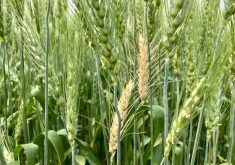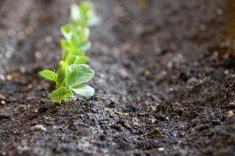Buffalo beans adorn the pastures, field edges and even kitchen tables of many Prairie farms and ranches — but the pretty plant is now also being picked for its potential properties as a cancer fighter.
Experiments show compounds extracted from buffalo bean leaves have potential to fight a class of cancers that includes multiple myeloma, according to Dr. Roy Golsteyn, who runs the Cancer Cell Laboratory at the University of Lethbridge.
Dr. Sophie Kerneis-Golsteyn, Golsteyn’s colleague and wife, led the study looking at the buffalo bean extracts.
Read Also

Senft to step down as CEO of Seeds Canada
Barry Senft, the founding CEO of the five-year-old Seeds Canada organization is stepping down as of January 2026.
In the lab, the buffalo bean showed anti-cancer activity right away, the university said in a recent release.
Researchers think buffalo beans will limit cancer cell growth by inhibiting a specific enzyme. Synthetic compounds are available to inhibit that enzyme, but they don’t work as well as researchers had hoped, the release said.
About half of today’s prescription drugs have their origins in plants, Golsteyn said, including a cancer drug called Taxol.
Used to treat breast, ovarian, and several other cancers, Taxol is derived from Pacific yew trees. “And that’s the No. 1, the best cancer drug discovered yet,” Golsteyn said.
The idea of looking at plants for cancer treatments isn’t new. “But oddly, the plants from Alberta, and from Saskatchewan for that matter, haven’t really been studied,” he said.
The Cancer Cell Lab is now working with a French pharmaceutical company that specializes in natural products chemistry. Its next step is to identify the chemical compound responsible for buffalo beans’ cancer-fighting properties.
Seeking help
Golsteyn and his team aren’t stopping at the buffalo bean. And they’re hoping farmers and ranchers can help them find other prairie plants that may have anti-cancer properties.
Researchers are particularly interested in plants which livestock purposely avoid eating.
Such plants produce chemicals to protect themselves against grazing, he said. “And usually those chemicals are pretty effective. In fact, sometimes they have the properties that we would like to see in… medical drugs.”
Golsteyn said researchers are also interested in finding out which plants First Nations used in traditional medicine. The team follows certain protocols when working with First Nations, he noted, rather than appropriating the knowledge.
Golsteyn also said people should know that supporting cancer research supports labs such as his. Charities such as the Alberta Cancer Foundation, along with the University of Lethbridge, fund the Cancer Cell Laboratory.
Farmers and ranchers can contact Golsteyn directly at 403-332-4553 or by email.
— Lisa Guenther is a field editor for Grainews and Country Guide at Livelong, Sask. Follow her on Twitter at @LtoG.
















